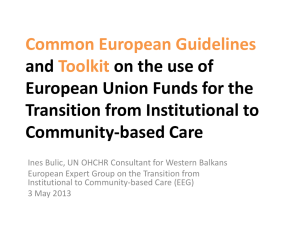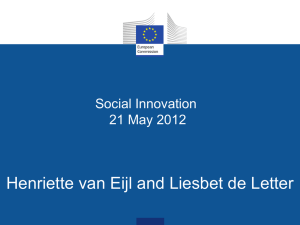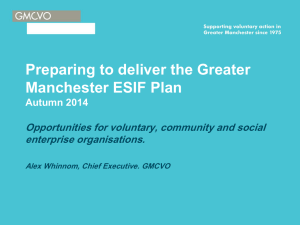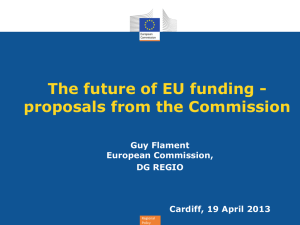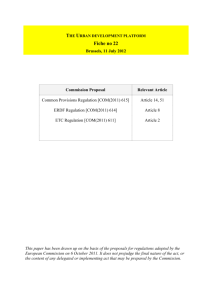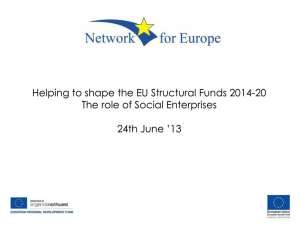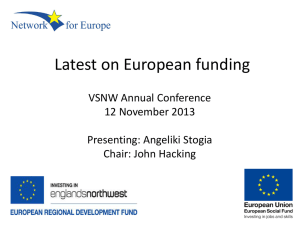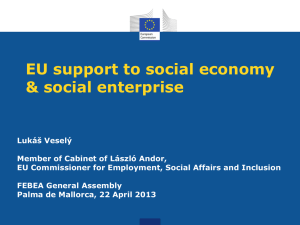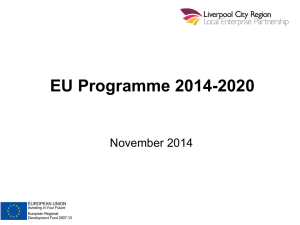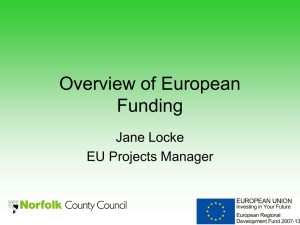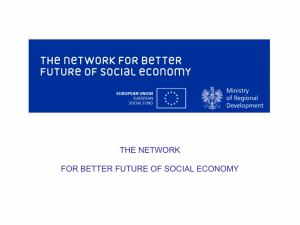Presentation - ENIL – European Network on Independent Living
advertisement
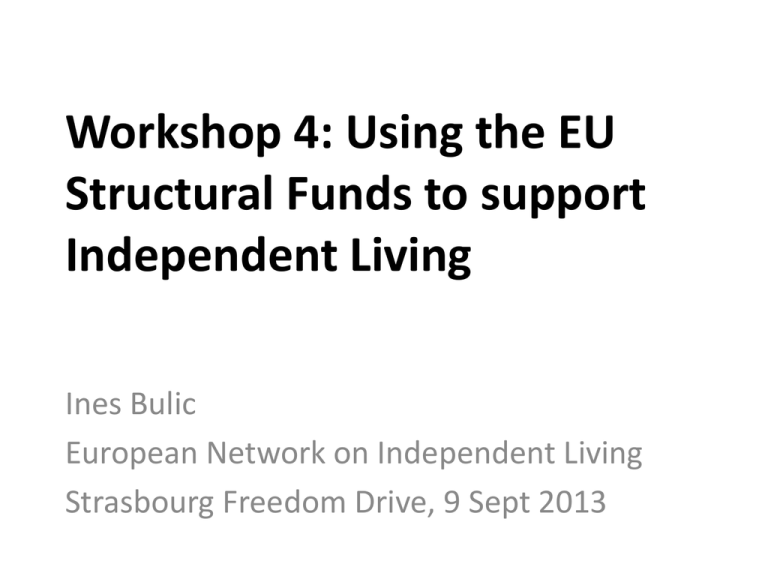
Workshop 4: Using the EU Structural Funds to support Independent Living Ines Bulic European Network on Independent Living Strasbourg Freedom Drive, 9 Sept 2013 What are the Structural Funds? • Financial tools to implement the EU’s regional policy • Convergence objective, Regional Competitiveness and Employment Objective and European Territorial Cooperation • Aim to reduce regional disparities within the EU • All regions are eligible for funding, but the poorer ones receive the most support • Relevant funds – European Social Fund, European Regional Development Fund, European Agricultural and Rural Development Fund • Current programming period 2007 – 2013, next period 2014 – 2020 • 2007 – 2013 – 347bn EUR – 201bn ERDF and 76bn ESF Using EU Structural Funds to support Independent Living MS can use the European Social Fund (ESF) to support: • Development of services, including early intervention, family support, foster care, personal assistance, rehabilitation, community-based residential support, independent living schemes and supported employment • Management of the change process • Development of a qualified workforce, including retraining institutional care staff MS can use the European Regional Development Fund (ERDF) to support: • Targeted investments in mainstream health and social infrastructure, education, housing and specialised services where necessary ERDF should not be used: • For building, renovation or modernisation of longstay residential institutions Regulatory framework 2007 - 2013 • General Regulation Article 16 – non-discrimination • Fund specific Regulations ESF to support actions “reinforcing the social inclusion of disadvantaged people with a view to their sustainable integration in employment and combating all forms of discrimination in the labour market”. ERDF to support “investments in health and social infrastructure which contribute to regional and local development and increasing the quality of life”. This is not reflected in how Structural Funds are used • In Romania, 29 MEUR SF used to renovate 39 existing institutions (2007 – 2013) • In Slovakia, more than 185 MEUR SF invested in renovating or constructing 130 institutions with 50+ residents (2008 – 2010) • In Bulgaria, plans to build 149 “small group homes” for 12 – 14 children each • In Hungary, SF can be used to build institutions for up to 50 people Lessons learned • Lack of clear direction on developing alternatives to institutional care • Residential institutions reconstructed, expanded and built • Restrictive interpretations of the rules for Structural Funds • Barriers to the development of community services • Lack of transparency • Poor monitoring and evaluation • Barriers faced by smaller to mid-size NGOs when applying for SF What next? Programming period 2014-2020 • European Commission’s proposals for Common Provisions Regulation and fund specific Regulations • Currently negotiated by the European Commission, the European Council and the European Parliament – the so-called trialogue • To be negotiated by the end of 2013 Clearer objectives • Supporting structural change in the health and social care systems • Combining investments into infrastructure with workforce development and improving mainstream services • Supporting sustainable reforms • Promoting social innovation • Simplified rules New regulatory framework 2014-2020 Common Provisions Regulation Thematic objectives Fund specific regulations (ERDF and ESF) Investment priorities Common Strategic Framework Key actions Common Provisions Regulation • Objective on promoting social inclusion and combating poverty • Need to comply with EU and national law (i.e. UN Convention on the Rights of Persons with Disabilities) • Prevention of discrimination Ex ante conditionalities •Thematic – strategy for a shift from residential to community-based care •General – mechanism to ensure effective implementation of UN CRPD Fund specific regulations • “Promoting social inclusion and combating poverty” an investment priority • Explicit reference to transition from institutional to community-based care • Principles of equal opportunities and nondiscrimination • Opportunities for civil society involvement Partnership contracts ESF and ERDF Operational Programmes Questions and indicators for the selection of projects to be funded by SF Monitoring Evaluations Toolkit on the use of EU Funds Main principles and the legal context Programming stage Implementation Monitoring and evaluation • What we mean by DI • Human rights argument for DI • Potential of EU funds • Current regulations 20072013 • Draft regulations 2014-2020 • Checklist for Partnership contracts • Indicative list of actions for ESF and ERDF • Output and result indicators for ESF and ERDF • Operational Programmes checklists • Checklist for the selection of projects • Checklist for monitoring • Lessons learned 2007-2013 • Checklist for evaluations Practical exercise Operational Programmes ERDF and ESF “Employment, Education and Social Inclusion” of a EU country for the period 2014-2020 • Identification of needs • List of actions • Indicators Questions • What infrastructure is needed in your country/region to support Independent Living? • What support services are needed in your country/region to facilitate Independent Living? • What list of actions would you propose to be included in the Operational Programmes? • Which indicators can be used to measure if the Structural Funds are supporting Independent Living? Useful publications • Toolkit on the Use of European Union Funds for the Transition from Institutional to Communitybased Care, November 2012 • Getting a Life: Living Independently and Being Included in the Community (legal analysis of SF potential to contribute to achievement of Article 19 of the UN CRPD), May 2012 • The European Union and the Right to Community Living: SF and the EU Obligations under the UN CRPD, May 2012 Contact details Ines Bulic ines.bulic@enil.eu Thank you!
